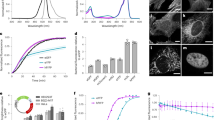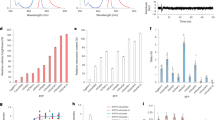Abstract
The utility of blue fluorescent protein (BFP) has been limited by its low quantum yield and rapid photobleaching. A library targeting residues neighboring the chromophore yielded a variant with enhanced quantum yield (0.55 versus 0.34), reduced pH sensitivity and a 40-fold increase in photobleaching half-life. This BFP, named Azurite, is well expressed in bacterial and mammalian cells and extends the palette of fluorescent proteins that can be used for imaging.
This is a preview of subscription content, access via your institution
Access options
Subscribe to this journal
Receive 12 print issues and online access
$209.00 per year
only $17.42 per issue
Buy this article
- Purchase on Springer Link
- Instant access to full article PDF
Prices may be subject to local taxes which are calculated during checkout

Similar content being viewed by others
References
Tsien, R.Y. Annu. Rev. Biochem. 67, 509–544 (1998).
Cubitt, A.B. et al. Trends Biochem. Sci. 20, 448–455 (1995).
Shaner, N.C., Steinbach, P.A. & Tsien, R.Y. Nat. Methods 2, 905–909 (2005).
Heim, R. & Tsien, R.Y. Curr. Biol. 6, 178–182 (1996).
Stauber, R.H. et al. Biotechniques 24, 462–466, 468–471 (1998).
Ellenberg, J., Lippincott-Schwartz, J. & Presley, J.F. Trends Cell Biol. 9, 52–56 (1999).
Lippincott-Schwartz, J. & Patterson, G.H. Science 300, 87–91 (2003).
Park, S., Yang, X. & Saven, J.G. Curr. Opin. Struct. Biol. 14, 487–494 (2004).
Dahiyat, B.I. & Mayo, S.L. Science 278, 82–87 (1997).
Neylon, C. Nucleic Acids Res. 32, 1448–1459 (2004).
Voigt, C.A., Mayo, S.L., Arnold, F.H. & Wang, Z.G. Proc. Natl. Acad. Sci. USA 98, 3778–3783 (2001).
Hayes, R.J. et al. Proc. Natl. Acad. Sci. USA 99, 15926–15931 (2002).
Wachter, R.M. et al. Biochemistry 36, 9759–9765 (1997).
Treynor, T.P., Vizcarra, C.L., Nedelcu, D. & Mayo, S.L. Proc. Natl. Acad. Sci. USA (in the press).
Bessette, P.H., Mena, M.A., Nguyen, A.W. & Daugherty, P.S. Methods Mol. Biol. 231, 29–37 (2003).
Campbell, R.E. et al. Proc. Natl. Acad. Sci. USA 99, 7877–7882 (2002).
Ellenberg, J., Lippincott-Schwartz, J. & Presley, J.F. Biotechniques 25, 838–842, 844–836 (1998).
Kummer, A.D. et al. Chembiochem 3, 659–663 (2002).
Mauring, K. et al. J. Phys. Chem. B 109, 12976–12981 (2005).
Acknowledgements
The authors thank K. Dane, A. Nguyen, P. Bessette and C. Gottstein for helpful discussions and Alexander Mikhailovsky for assistance with fluorescence lifetime measurements, and acknowledge support from National Institutes of Health–National Institute of Biomedical Imaging and Bioengineering grant EB-000205.
Author information
Authors and Affiliations
Contributions
M.A.M., T.P.T., S.L.M. and P.S.D. designed research, M.A.M. and T.P.T. performed research, T.P.T. and S.L.M. contributed computational tools, M.A.M., T.P.T. and P.S.D. analyzed data, and M.A.M. and P.S.D. wrote the paper.
Corresponding author
Ethics declarations
Competing interests
The authors declare no competing financial interests.
Supplementary information
Supplementary Fig. 1
Crystal structure of BFP with chromophore (blue) and targeted residues (red). (PDF 225 kb)
Supplementary Fig. 2
Photophysical characterization of BFP variants. (PDF 18 kb)
Supplementary Fig. 3
Fluorescence lifetime analysis of BFP mutants. (PDF 25 kb)
Supplementary Fig. 4
Fluorescence of BFP variants with varying pH. (PDF 14 kb)
Supplementary Fig. 5
Whole-cell fluorescence development of E. coli cells expressing Azurite and EGFP. (PDF 18 kb)
Supplementary Fig. 6
Non-denaturing polyacrylamide gel electrophoresis of BFP variants. (PDF 742 kb)
Supplementary Fig. 7
Alignment of wtGFP, BFP, A5, and Azurite Amino Acid Sequences. (PDF 31 kb)
Supplementary Fig. 8
Alignment of WT GFP, BFP, A5 and Azurite Amino Acid sequences. (PDF 30 kb)
Supplementary Table 1
Amino acid composition of BFP degenerate codon library (PDF 14 kb)
Supplementary Table 2
Degenerate codon library design for structurally targeted mutagenesis and isolated BFP variants (PDF 15 kb)
Rights and permissions
About this article
Cite this article
Mena, M., Treynor, T., Mayo, S. et al. Blue fluorescent proteins with enhanced brightness and photostability from a structurally targeted library. Nat Biotechnol 24, 1569–1571 (2006). https://doi.org/10.1038/nbt1264
Received:
Accepted:
Published:
Issue Date:
DOI: https://doi.org/10.1038/nbt1264
This article is cited by
-
A short guide on blue fluorescent proteins: limits and perspectives
Applied Microbiology and Biotechnology (2024)
-
Extension of the short wavelength side of fluorescent proteins using hydrated chromophores, and its application
Communications Biology (2022)
-
A highly photostable and bright green fluorescent protein
Nature Biotechnology (2022)
-
Single-cell imaging and transcriptomic analyses of endogenous cardiomyocyte dedifferentiation and cycling
Cell Discovery (2019)
-
Generation of a variety of stable Influenza A reporter viruses by genetic engineering of the NS gene segment
Scientific Reports (2015)



